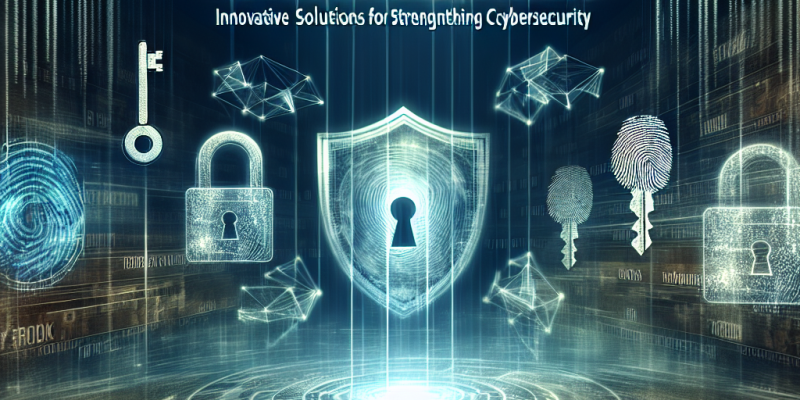Beyond Passwords: Innovative Solutions for Strengthening Cybersecurity

Beyond Passwords: Innovative Solutions for Strengthening Cybersecurity
In an increasingly digital world, where personal and organizational data breaches have become commonplace, relying solely on passwords for cybersecurity is no longer viable. Cybercriminals are developing sophisticated methods to crack passwords, whether through brute-force attacks, phishing, or social engineering. As the perimeter of cyber threats widens, it becomes imperative to explore innovative solutions that go beyond traditional password systems. Here, we delve into groundbreaking strategies and technologies that are redefining cybersecurity.
The Limitations of Passwords
Passwords have been the cornerstone of digital security for decades, but they are fraught with limitations:
- Human Error: Users often create weak passwords, reuse them across multiple accounts, or forget them entirely, leading to compromised security.
- Phishing Attacks: Cybercriminals can easily exploit human psychology to trick users into revealing their passwords.
- Data Breaches: Large-scale data leaks often result in millions of passwords being exposed, undermining the security of countless accounts.
Given these vulnerabilities, organizations and individuals must look for alternatives that offer enhanced protection and user convenience.
Multifactor Authentication (MFA)
One of the most widely adopted alternatives to passwords is Multifactor Authentication (MFA). MFA requires users to provide two or more verification factors to gain access to a resource, combining something they know (a password), something they have (a smartphone or security token), and something they are (biometric data).
Benefits of MFA:
- Increased Security: Even if a password is compromised, unauthorized access is thwarted by the requirement for additional verification.
- User Assurance: MFA fosters confidence in users, knowing that their data is better protected.
Biometric Authentication
Biometric authentication leverages unique physical or behavioral characteristics to verify identity. Common forms include fingerprint scans, facial recognition, voice recognition, and even retinal scans.
Advantages of Biometric Authentication:
- Convenience: Biometric authentication often requires less user effort, as it doesn’t necessitate remembering complex passwords.
- Enhanced Security: Biometric traits are unique to each individual, making it significantly more difficult for attackers to impersonate legitimate users.
Passwordless Authentication
The emergence of passwordless authentication methods, such as one-time passcodes, magic links, and push notifications, presents an attractive alternative. These systems allow users to verify their identity without entering a traditional password.
Key Features:
- Simplicity: Users receive a link or code via email or SMS, simplifying the log-in process.
- Reduced Risk: With no passwords to steal, attackers have fewer entry points to exploit.
Blockchain Technology in Identity Management
Blockchain technology is revolutionizing how we manage and secure identities. Using decentralized identity systems based on blockchain, users can control their digital identities without relying on centralized authorities.
Potential Benefits:
- Enhanced Privacy: Users can selectively share attributes of their identity without revealing sensitive information.
- Immutability: The nature of blockchain makes it exceedingly difficult to alter or counterfeit credentials.
Zero Trust Security Model
The Zero Trust security model operates on the principle of assuming that threats could be internal or external. Therefore, it enforces strict identity verification processes for every person and device attempting to access resources.
Key Features of Zero Trust:
- Continuous Verification: Identity verification is not a one-time event; it occurs continuously.
- Least Privilege Access: Access is granted only on a need-to-know basis, reducing the attack surface.
Cybersecurity Education and Awareness
Technical solutions alone are insufficient to address cybersecurity challenges. Human behavior and awareness play a pivotal role in strengthening defenses. Regular training and awareness programs can educate users about best practices and the latest cyber threats.
Essential Focus Areas:
- Phishing Awareness: Educating users about recognizing suspicious emails and links.
- Safe Browsing Habits: Encouraging the use of secure connections (HTTPS) and avoiding public Wi-Fi for sensitive transactions.
Conclusion
As cyber threats become increasingly sophisticated, organizations and individuals must move beyond traditional password systems to protect their digital assets. Innovations such as multifactor authentication, biometric recognition, passwordless authentication, blockchain, the Zero Trust model, and robust user education are all crucial components of a comprehensive cybersecurity strategy. By embracing these emerging technologies and methodologies, we can create a more secure digital landscape, reducing vulnerabilities and enhancing overall cybersecurity resilience. In a world where data is a new currency, investing in these innovative solutions is paramount to safeguarding our digital future.














